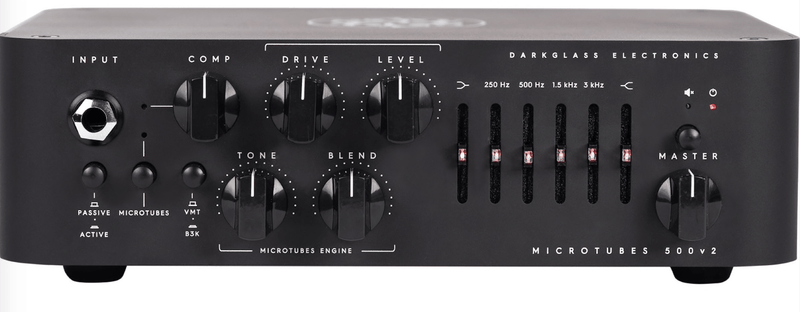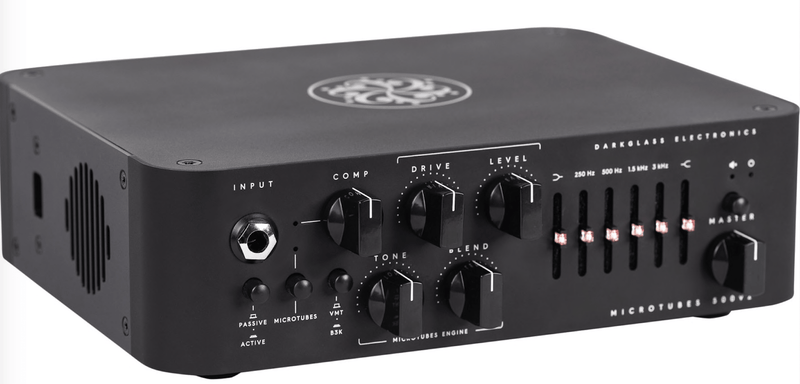

The Microtubes® 500 is a 500W amplifier equipped with a fully analog solid-state preamplifier and a Class D power module. On the top row you will find the clean section which is the basis of your your. It features a gain control and a 4-band active EQ: along with the Low and Treble controls, you'll find Low Mids and Hi Mids controls, each knob with its own 2-way frequency switch. On the bottom row you'll find the Microtubes Engine®, an additional channel that will take your clean sound to the next level by helping you cut through the mix while adding something subtle, tube, harmonics and compression natural to obliterating distortion. .
“INPUT” Connect your instrument via a standard ¼” mono cable.
“PASSIVE/ACTIVE”f Switch from passive mode to active mode. Some active basses may have a warmer signal output which can cause early amplifier distortion (feel free to use it in passive mode even with active bass if such additional distortion is desired).
“MICROTUBE” Engages the Microtubes Engine™ to add natural compression, organic harmonic enhancement, and saturation ranging from mild overdrive to high-gain bass rage. The Microtubes Engine operates before the clean section (so you can use the 4-band active EQ for additional sound shaping in addition to the Tone knob described below).
“DRIVE” Adjusts the distortion level of the Microtubes motor. Ranging from smooth, warm overdrive to devastating saturation and everything in between.
“TONE” Controls the high harmonic content of the Microtubes engine via a variable low-pass filter: increase it for additional attack and definition or decrease it for a softer sound. This is handy when running bright EQ settings or speakers with tweeters.
“LEVEL” the output volume of the Microtubes motor.
“MIX” Mix between Clean and Distortion signals (Microtubes Engine). B3K/VMT Selects between two overdrive circuits: B3K mode will provide an aggressive, percussive sound while VMT will bring up the mids for a warmer, more neutral character.
“GAIN” Modifies the volume of the signal driving the active 4-band equalizer. You can set it low for a cleaner sound or set it higher for a more aggressive growl.
“BASS” + -12 dB at 80 Hz. Changes the low content of the signal.
“LOW MID” + -12 dB of the frequency selected via the LOW MIDS ƒ switch (described below).
“LOW MID” ƒ Use this switch to change the low mid band frequency between 250 Hz and 500 Hz.
“HI MID” + -12 dB of the frequency selected via the HI MIDS ƒ switch (described below).
“HI MID” ƒ Use this switch to change the high mid band frequency between 1.5 kHz and 3 kHz.
“TREBLE” + -12 dB at 5 kHz. Changes the high content of the signal.
“MASTER” Controls the overall volume of the amplifier. This control does not affect the DI output or effects loop level.
“MUTE” Mutes the amplifier. Footswitch The Footswitch jack allows you to remotely activate and disengage the microtubes motor via our smart footswitch (sold separately). Hold the footswitch to mute the amplifier. The VMT/B3K push button will remain operational with the smart pedal connected. * Use a regular mono instrument cable to connect the amplifier to the pedal. * Remove the cable from the footswitch jack on the rear panel if you want to control the amp from the front panel. *The Microtubes 500 will only work with our exclusive Smart Pedal or Super Smart Pedal (sold separately). A generic footswitch will not work with the Microtubes 500.
DIMENSIONS 23.2x19x7.3 mm (9.13x7.48x2.87 inches)
CAUTION · Do not open the amplifier. No user-serviceable parts inside · Make sure the voltage selector switch on the right side panel is set correctly (115V/230V) before plugging the amplifier into the AC outlet. · Never use the amplifier in a very humid environment or near liquids. · Microtubes 500 can deliver over 115 dB of SPL. Exposure to this sound level can damage your hearing. Use appropriate hearing protection if exposed. · Microtubes 500 can provide up to 750 watts of power output for a short period of time. Make sure your enclosure is designed to support the power supply. · Do not cover the ventilation holes. The fan and ventilation holes are part of the amplifier's cooling system. Covering the ventilation holes may cause the power amplifier to overheat and damage it. · Do not use an instrument cable as a speaker cable. Instrument cables are not designed to deliver power signals from the amplifier to the speaker. Using an instrument cable may damage the amplifier and the cable.


